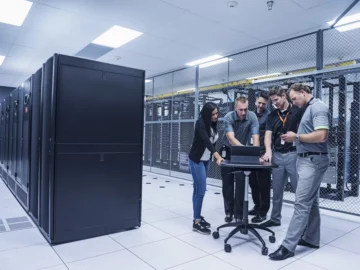
October 3, 2023
If you play fantasy football, you are no stranger to data-driven decision-making. Every week during football season, an estimated 60 million Americans pore over player statistics, point projections and trade proposals, looking for those elusive insights to guide their roster decisions and lead them to victory. But numbers only tell half the story.
For the past seven years, ESPN has worked closely with IBM to help tell the whole tale. And this year, ESPN Fantasy Football is using AI models built with watsonx to provide 11 million fantasy managers with a data-rich, AI-infused experience that transcends traditional statistics.
In fantasy football, success hinges on decisions fueled by information and insights. Each football season, millions of articles, blog posts, podcasts and videos are produced by the media, offering expert analysis on everything from player performance to injury reports. Every week, dedicated fans analyze player statistics, projections and trade options, all in pursuit of that elusive edge. However, the challenge lies in harnessing the wealth of “unstructured” data that permeates the sports media landscape. For decades, this treasure trove of expertise went largely untapped by fantasy footballers, who could only consume a tiny fraction of this precious content. Not anymore.
To identify and distill the insights locked inside this sea of data, ESPN and IBM tapped into the power of watsonx—IBM’s new AI and data platform for business—to build AI models that understand the language of football. The models are expected to produce more than 48 billion insights for fantasy manager this year—everything from recommending mutually beneficial trade opportunities to identifying waiver wire players that are best suited to meet a team’s specific needs.
Serious business
Fantasy sports are more than fun and games. It’s also a $9 billion industry. And for ESPN, fantasy football is a critical driver of digital engagement. To keep its experience fresh and competitive, ESPN needs to introduce new features and enhancements that drive customer satisfaction and new membership.
“We want ESPN to be the destination for all fans playing Fantasy Football, whether it’s their first time or they’ve been managing a league for 20 years,” says Chris Jason, Executive Director, Product Management at ESPN. “To meet that bar, we have to continuously improve the game and find ways to enhance the experience with new innovations.”
To help, ESPN partnered with IBM Consulting using the IBM Garage methodology to better understand the kinds of data-driven insights fantasy players want. Together, they created unique Player Insights now integrated into the ESPN fantasy football app: Waiver Grades and Trade Grades.
Waiver Grades and Trade Grades use containerized applications—software packages that include everything needed to run the application—built on Red Hat OpenShift, a platform for managing and orchestrating containerized applications. These applications are all hosted on the IBM Cloud to ensure uninterrupted availability.
Encouraging trades and transactions
These new features are powered by AI models built with watsonx, and are designed to provide users with more information to help them make the best roster decisions possible.
Using neural networks and advanced natural language processing, Waiver Grades give a personalized rating for the value a player would add to your team. This nuanced algorithm delves deep into your roster to make realistic projections based on your team’s fluctuating strengths and weaknesses. For example, if you have an excellent quarterback on a bye week, your waiver grade might not be as high for a replacement quarterback—given you already have a strong one.
“An active league is a fun league,” says Jason. “So, we want to encourage roster moves and trading between teams. These features help us do just that.”
Trade Grades are another new feature that helps managers assess the value of potential trades. When managers initiate transactions with each other, the AI models serves up trade insights, featuring a grade for each athlete involved in the trade and a grade for the trade’s overall value. With one look, managers can tell if their trade is a good deal. Once the managers have these insights, they can move ahead with the trade, cancel it or edit the trade package.
Managers can also use the AI models to analyze structured and unstructured data to compare players, estimate the potential upside and downside of starting a particular player and assess the impact of an injury. These “boom-and-bust” analyses allow fantasy owners to see the risk-and-reward scenarios, trends over time, and field a more competitive team.
“Because we’re incorporating insight from media experts, it presents a more comprehensive analysis of a player’s potential on any given week,” says Aaron Baughman, Distinguished Engineer and Master Inventor with IBM Consulting.
The AI models built with watsonx ingest and analyze millions of news stories, opinion pieces by fantasy experts, and reports on player injuries. The resulting insights correlate with traditional statistical data on more than 1,900 players across all 32 teams to help fantasy managers decide who to start weekly.
A dynamic league with personalized insights
Throughout this seven-year partnership, IBM’s AI models have produced hundreds of billions of AI-generated insights for ESPN’s fantasy football platform. Waiver Grades, Trade Grades, and Player Insights with Watson use AI to spawn fresh insights from available data, breathing new life into the user experience and encouraging better decisions by fantasy managers. But they also make ESPN Fantasy Football more fun and engaging. And the partnership with ESPN allows IBM to demonstrate AI’s ability to transform massive quantities of data into meaningful insights, something business leaders seek in every industry.
More from Artificial intelligence

October 4, 2023
Achieve your AI goals with an open data lakehouse approach
3 min read – Artificial intelligence (AI) is now at the forefront of how enterprises work with data to help reinvent operations, improve customer experiences, and maintain a competitive advantage. It’s no longer a nice-to-have, but an integral part of a successful data strategy. The first step for successful AI is access to trusted, governed data to fuel and scale the AI. With an open data lakehouse architecture approach, your teams can maximize value from their data to successfully adopt AI and enable better,…
<!—->

September 27, 2023
Open source large language models: Benefits, risks and types
6 min read – Large language models (LLMs) are foundation models that use artificial intelligence (AI), deep learning and massive data sets, including websites, articles and books, to generate text, translate between languages and write many types of content. There are two types of these generative AI models: proprietary large language models and open source large language models. https://www.youtube.com/watch?v=5sLYAQS9sWQ In this video, Martin Keen briefly explains large language models, how they relate to foundation models, how they work and how they can be used…
<!—->

September 25, 2023
Unleashing the power of Presto: The Uber case study
7 min read – The magic behind Uber’s data-driven success Uber, the ride-hailing giant, is a household name worldwide. We all recognize it as the platform that connects riders with drivers for hassle-free transportation. But what most people don’t realize is that behind the scenes, Uber is not just a transportation service; it’s a data and analytics powerhouse. Every day, millions of riders use the Uber app, unwittingly contributing to a complex web of data-driven decisions. This blog takes you on a journey into…
<!—->

September 21, 2023
IBM TechXchange underscores the importance of AI skilling and partner innovation
3 min read – Generative AI and large language models are poised to impact how we all access and use information. But as organizations race to adopt these new technologies for business, it requires a global ecosystem of partners with industry expertise to identify the right enterprise use-cases for AI and the technical skills to implement the technology. During TechXchange, IBM’s premier technical learning event in Las Vegas last week, IBM Partner Plus members including our Strategic Partners, resellers, software vendors, distributors and service…
<!—->
- SEO Powered Content & PR Distribution. Get Amplified Today.
- PlatoData.Network Vertical Generative Ai. Empower Yourself. Access Here.
- PlatoAiStream. Web3 Intelligence. Knowledge Amplified. Access Here.
- PlatoESG. Carbon, CleanTech, Energy, Environment, Solar, Waste Management. Access Here.
- PlatoHealth. Biotech and Clinical Trials Intelligence. Access Here.
- Source: https://www.ibm.com/blog/ibm-watson-and-espn-use-ai-to-transform-fantasy-football-data-into-insight/
- :has
- :is
- :not
- $9 Billion
- $UP
- 1
- 11
- 20
- 20 years
- 2023
- 25
- 27
- 30
- 300
- 31
- 32
- 40
- 400
- 41
- 60
- 9
- a
- Aaron
- ability
- access
- Achieve
- across
- active
- add
- adopt
- advanced
- ADvantage
- Advertising
- ahead
- AI
- AI models
- AI-powered
- algorithm
- All
- allow
- allows
- already
- also
- Americans
- amp
- an
- analysis
- analytics
- analyze
- and
- Another
- any
- anymore
- app
- applications
- approach
- architecture
- ARE
- article
- articles
- artificial
- artificial intelligence
- Artificial intelligence (AI)
- AS
- assess
- At
- Athlete
- author
- availability
- available
- back
- bar
- based
- BE
- been
- behind
- behind the scenes
- beneficial
- benefits
- BEST
- Better
- between
- Billion
- billions
- Blog
- Blog Posts
- blogs
- Books
- breathing
- briefly
- build
- built
- business
- Business Leaders
- but
- by
- CAN
- carbon
- card
- Cards
- case
- case study
- CAT
- challenge
- check
- Chris
- CIS
- class
- closely
- Cloud
- color
- comments
- compare
- competitive
- complex
- comprehensive
- connects
- consulting
- consume
- Container
- content
- continue
- continuously
- contributing
- could
- created
- critical
- CSS
- custom
- customer
- Customer satisfaction
- data
- Data Platform
- data sets
- data strategy
- data-driven
- Date
- day
- deal
- decades
- decide
- Decision Making
- decisions
- dedicated
- deep
- deep learning
- Default
- definitions
- demonstrate
- description
- designed
- designers
- destination
- developers
- digital
- Director
- discover
- Distinguished
- distributors
- do
- don
- downside
- drive
- driver
- drivers
- during
- dynamic
- each
- ecosystem
- Edge
- enable
- encourage
- encouraging
- engagement
- engaging
- engineer
- enhance
- enhancements
- ensure
- Enter
- Enterprise
- enterprises
- Entertainment
- ESPN
- estimate
- estimated
- Ether (ETH)
- Event
- Every
- every day
- everything
- example
- excellent
- executive
- Executive Director
- Exit
- expected
- experience
- Experiences
- expert
- expertise
- experts
- Explains
- fans
- FANTASY
- Feature
- Features
- Featuring
- field
- Find
- First
- first time
- follow
- fonts
- Football
- For
- forefront
- Foundation
- fraction
- fresh
- from
- Fuel
- fueled
- fun
- game
- Games
- garage
- generate
- generative
- Generative AI
- generator
- giant
- Give
- given
- Global
- Goals
- good
- governed
- grade
- Grid
- guide
- Half
- Harnessing
- hat
- Have
- height
- help
- helps
- High
- hinges
- holding
- hosted
- household
- How
- However
- HTTPS
- Hundreds
- IBM
- IBM Cloud
- IBM Watson
- ICO
- ICON
- identify
- identifying
- if
- image
- Impact
- implement
- importance
- improve
- in
- include
- Including
- incorporating
- index
- industry
- information
- initiate
- Innovation
- innovations
- inside
- insight
- insights
- integral
- integrated
- Intelligence
- into
- introduce
- involved
- IT
- ITS
- journey
- jpg
- just
- Keen
- Keep
- landscape
- language
- Languages
- large
- largely
- LAS
- Las Vegas
- Last
- lead
- leaders
- League
- learning
- lies
- Life
- locale
- locked
- longer
- Look
- looking
- magic
- maintain
- make
- man
- management
- manager
- Managers
- managing
- many
- Martin
- massive
- master
- max-width
- Maximize
- meaningful
- Media
- media experts
- Meet
- Members
- membership
- Methodology
- might
- million
- millions
- min
- minutes
- Mobile
- model
- models
- more
- most
- move
- moves
- mutually
- name
- Natural
- Natural Language
- Natural Language Processing
- Navigation
- needed
- needs
- networks
- Neural
- neural networks
- New
- new feature
- New Features
- New technologies
- news
- no
- nothing
- now
- numbers
- october
- of
- offering
- on
- once
- ONE
- only
- open
- open data
- open source
- Operations
- Opinion
- opportunities
- optimized
- Options
- or
- organizations
- Other
- our
- over
- overall
- owners
- package
- packages
- page
- part
- particular
- partner
- partnered
- partners
- Partnership
- past
- People
- performance
- Personalized
- PHP
- pieces
- platform
- plato
- Plato Data Intelligence
- PlatoData
- Play
- player
- players
- playing
- plugin
- plus
- Podcasts
- Point
- poised
- policy
- position
- possible
- Post
- Posts
- potential
- power
- powered
- Precious
- premier
- presents
- processing
- produce
- Produced
- Product
- product management
- Program
- projections
- Proposals
- proprietary
- provide
- pursuit
- Race
- rating
- Reading
- realistic
- realize
- recognize
- recommending
- Red
- Red Hat
- reinvent
- replacement
- Reports
- requires
- responsive
- resulting
- riders
- right
- risks
- robots
- roster
- Roster Moves
- Run
- s
- satisfaction
- says
- Scale
- scenarios
- scenes
- Screen
- scripts
- SEA
- Season
- see
- Seek
- seo
- September
- serves
- service
- serving
- Sets
- seven
- site
- skills
- Software
- something
- Source
- Spawn
- specific
- Sponsored
- Sports
- start
- Starting
- statistical
- statistics
- Step
- Stories
- Story
- stranger
- Strategic
- strategic partners
- Strategy
- strengths
- strong
- structured
- structured and unstructured data
- Study
- success
- successful
- Successfully
- T
- takes
- tale
- Tapped
- team
- teams
- Technical
- technical skills
- Technologies
- Technology
- tell
- text
- than
- that
- The
- their
- Them
- theme
- There.
- These
- they
- this
- this year
- those
- time
- Title
- to
- together
- top
- trade
- trades
- Trading
- traditional
- Transactions
- transcends
- Transform
- translate
- transportation
- Trends
- trusted
- two
- tyler
- type
- types
- Uber
- underscores
- understand
- unique
- unleashing
- untapped
- Upside
- URL
- us
- use
- use-cases
- User
- User Experience
- users
- using
- value
- VEGAS
- vendors
- victory
- Video
- Videos
- W
- want
- Watson
- ways
- we
- weaknesses
- Wealth
- web
- websites
- week
- weekly
- went
- What
- when
- whether
- WHO
- whole
- Wire
- with
- WordPress
- Work
- worked
- worldwide
- would
- write
- written
- year
- years
- you
- Your
- youtube
- zephyrnet











